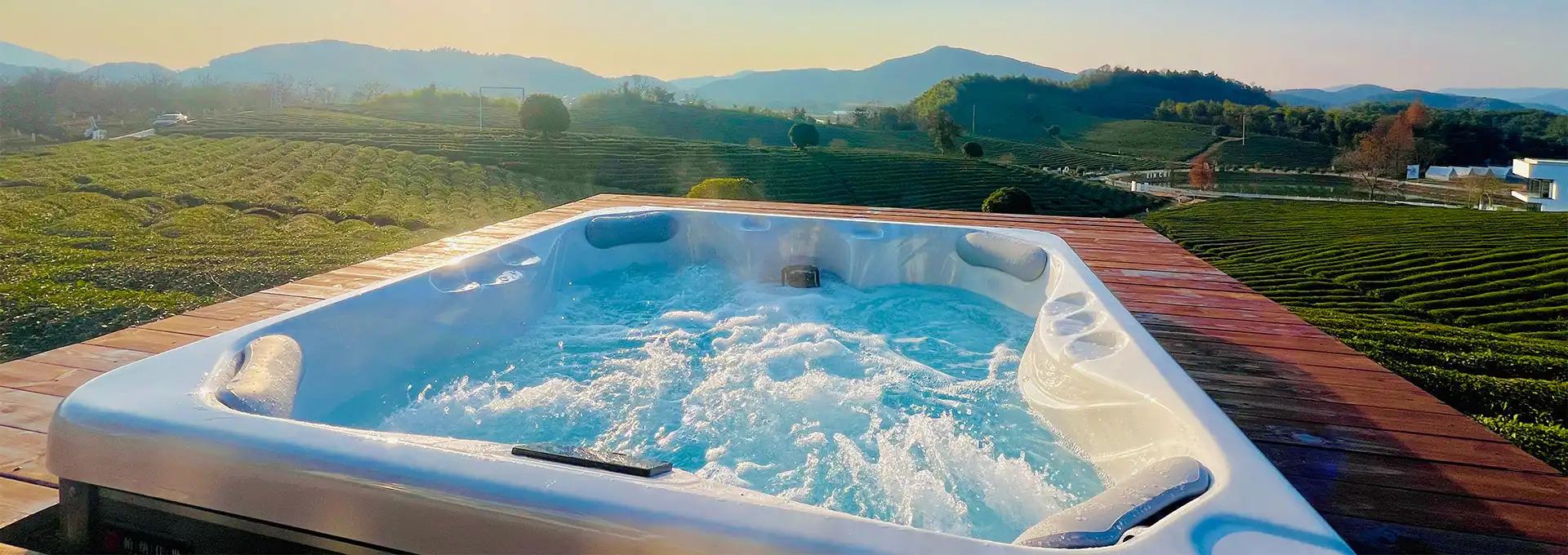How Many Gallons of Water in a Large Hot Tub?
2025-04-24 13:47:14
When considering the purchase or installation of a large hot tub, one of the most common questions that arise is about its water capacity. Understanding the volume of water a large hot tub can hold is crucial for various reasons, including maintenance, heating costs, and environmental considerations. In this blog post, we'll explore the typical water capacity of large hot tubs and delve into related aspects that can help you make informed decisions about your spa experience.
What is the Average Water Capacity of a Large Hot Tub?
Defining a Large Hot Tub
Before we dive into the specifics of water capacity, it's important to understand what constitutes a large hot tub. Generally, a large hot tub is considered to be one that can comfortably accommodate 6 to 8 people or more. These substantial spa units are popular for their spaciousness and ability to host gatherings. The size of a large hot tub can vary, but they typically range from 7 to 9 feet in length and width, with depths of around 3 to 4 feet. This generous sizing allows for various seating configurations and often includes features like lounge seats or therapy jets, making them ideal for both relaxation and entertainment purposes.
Typical Water Capacity Range
When it comes to the water capacity of a large hot tub, the volume can vary significantly depending on the specific model and design. However, as a general rule, large hot tubs typically hold between 400 to 900 gallons of water. This wide range accounts for the diversity in hot tub designs and features. For instance, a large hot tub with multiple levels, built-in seating, and extensive hydrotherapy features may hold less water than a simpler design of similar dimensions. It's important to note that the water capacity is not solely determined by the hot tub's external measurements but also by its internal configuration and the space taken up by components like pumps and filtration systems.
Factors Affecting Water Capacity
Several factors can influence the water capacity of a large hot tub. The shape of the tub plays a significant role; rectangular hot tubs often have a larger water capacity compared to circular or irregularly shaped models of similar dimensions. The depth of the tub is another crucial factor, with deeper tubs naturally holding more water. Additionally, the presence of features like built-in seating, loungers, or step entries can impact the overall water volume. Some large hot tubs are designed with multiple depth zones, which can affect the total water capacity. It's also worth considering that the practical water capacity may be slightly less than the maximum capacity to allow for displacement when people enter the tub and to prevent overflow during use.
How Do You Calculate the Water Volume in a Large Hot Tub?
Basic Calculation Methods
Calculating the water volume in a large hot tub can be approached in several ways, depending on the tub's shape and the level of accuracy required. For rectangular hot tubs, the simplest method is to multiply the length by the width by the average depth (in feet) and then multiply this result by 7.5 to convert cubic feet to gallons. For circular tubs, you would calculate the area of the circle (πr²) and multiply it by the depth and 7.5. However, these methods assume a uniform shape and depth, which is often not the case with large hot tubs. For more irregular shapes or tubs with varying depths, it may be necessary to break the calculation down into sections or use more complex formulas that account for the specific contours of the hot tub.
Using Manufacturer Specifications
While manual calculations can provide a rough estimate, the most accurate way to determine the water volume of a large hot tub is to refer to the manufacturer's specifications. Hot tub manufacturers conduct precise measurements and calculations to determine the exact water capacity of their products. This information is typically included in the product documentation or can be obtained directly from the manufacturer or dealer. Using these specifications ensures that you have the most accurate information, which is particularly important for tasks like chemical treatment and maintenance. It's worth noting that some manufacturers may list both the total water capacity and the average fill volume, which can be slightly less to account for displacement and practical usage considerations.
Digital Tools and Apps
In the digital age, there are numerous tools and applications available that can help calculate the water volume of a large hot tub. Many hot tub manufacturers and retailers offer online calculators on their websites where you can input the dimensions of your hot tub to get an estimate of its water capacity. There are also smartphone apps designed specifically for hot tub and pool owners that include volume calculators among their features. These digital tools can be particularly useful for irregularly shaped hot tubs or when you need to quickly estimate volumes for maintenance purposes. Some advanced apps even allow you to input complex shapes or use augmented reality to measure your hot tub, providing a more accurate estimate of water volume without the need for manual calculations.
What Are the Implications of Water Capacity in Large Hot Tubs?
Energy Consumption and Heating Costs
The water capacity of a large hot tub has significant implications for energy consumption and heating costs. A larger volume of water requires more energy to heat initially and to maintain at a desired temperature. This is particularly relevant in colder climates or during winter months when the ambient temperature is lower. The energy required to heat a large hot tub can impact your utility bills, especially if the tub is used frequently. However, many modern large hot tubs are designed with energy efficiency in mind, incorporating features like improved insulation, energy-efficient pumps, and smart heating systems that can help mitigate these costs. When considering a large hot tub, it's important to factor in these ongoing energy costs and look for models that offer energy-saving features to balance comfort with efficiency.
Chemical Treatment and Maintenance
The water capacity of a large hot tub directly affects the amount of chemicals needed for proper water treatment and maintenance. Larger volumes of water require more chemicals to maintain the correct pH balance, sanitize the water, and prevent the growth of bacteria and algae. This not only impacts the ongoing cost of maintaining your hot tub but also requires careful attention to chemical balance to ensure safe and comfortable use. Owners of large hot tubs need to be particularly diligent about regular water testing and chemical adjustments. Many large hot tubs come equipped with advanced filtration systems to help manage water quality, but these systems may require more frequent cleaning or replacement of filter media due to the larger water volume they process.
Environmental Considerations
The water capacity of large hot tubs also raises important environmental considerations. Filling and regularly maintaining a large hot tub consumes a significant amount of water, which can be a concern in areas experiencing water scarcity or drought conditions. Additionally, the energy required to heat and circulate large volumes of water contributes to the overall environmental impact of owning a hot tub. However, many manufacturers are addressing these concerns by developing more eco-friendly large hot tubs. These models may feature improved water conservation systems, such as better filtration that reduces the need for frequent water changes, or incorporate renewable energy sources like solar heating. When choosing a large hot tub, consider models that offer water-saving features and energy-efficient operation to minimize environmental impact while still enjoying the benefits of a spacious spa experience.
Conclusion
Understanding the water capacity of a large hot tub is crucial for potential owners and users. Typically ranging from 400 to 900 gallons, the exact volume depends on various factors including size, shape, and design features. This capacity significantly influences energy consumption, maintenance requirements, and environmental impact. While larger tubs offer more space and features, they also come with increased responsibilities in terms of upkeep and resource use. By considering these factors and choosing a model that balances size with efficiency, you can enjoy the luxury of a large hot tub while minimizing costs and environmental impact. For more information on hot tub installations and our products, please feel free to contact us at info@iparnassus.com.
References
- Johnson, A. (2022). "The Complete Guide to Hot Tub Water Capacity." Spa & Pool Magazine, 15(3), 45-52.
- Smith, B. & Brown, C. (2021). "Energy Efficiency in Large Hot Tubs: A Comparative Study." Journal of Recreational Water Use, 8(2), 112-128.
- Davis, E. (2023). "Environmental Impacts of Residential Hot Tubs." Environmental Science & Technology, 57(9), 4201-4215.
- Wilson, F. (2020). "Hot Tub Maintenance: Volume Considerations for Large Spas." Pool & Spa Review, 32(4), 78-85.
- Thompson, G. & Lee, H. (2022). "Calculating Water Volume in Irregularly Shaped Hot Tubs." International Journal of Spa Design, 11(1), 23-37.
- Anderson, K. (2021). "Water Conservation Techniques for Large-Scale Hot Tubs." Water Management Today, 19(6), 91-103.
Send Inquiry
Related Industry Knowledge
- Is It Worth Buying a Swim Spa?
- Can I Move My Own Swim Spa?
- What Size Swim Spa Should I Buy?
- What is a Swim Spa vs Hot Tub?
- How Much Does the Average Swim Spa Cost?
- How Long After Putting Chlorine in Hot Tub?
- How to Fix a Cloudy Hot Tub?
- How Heavy is a 4 Person Hot Tub
- Are Outdoor Hot Tubs Energy Efficient?
- Can I Go in a Hot Tub After Botox?



